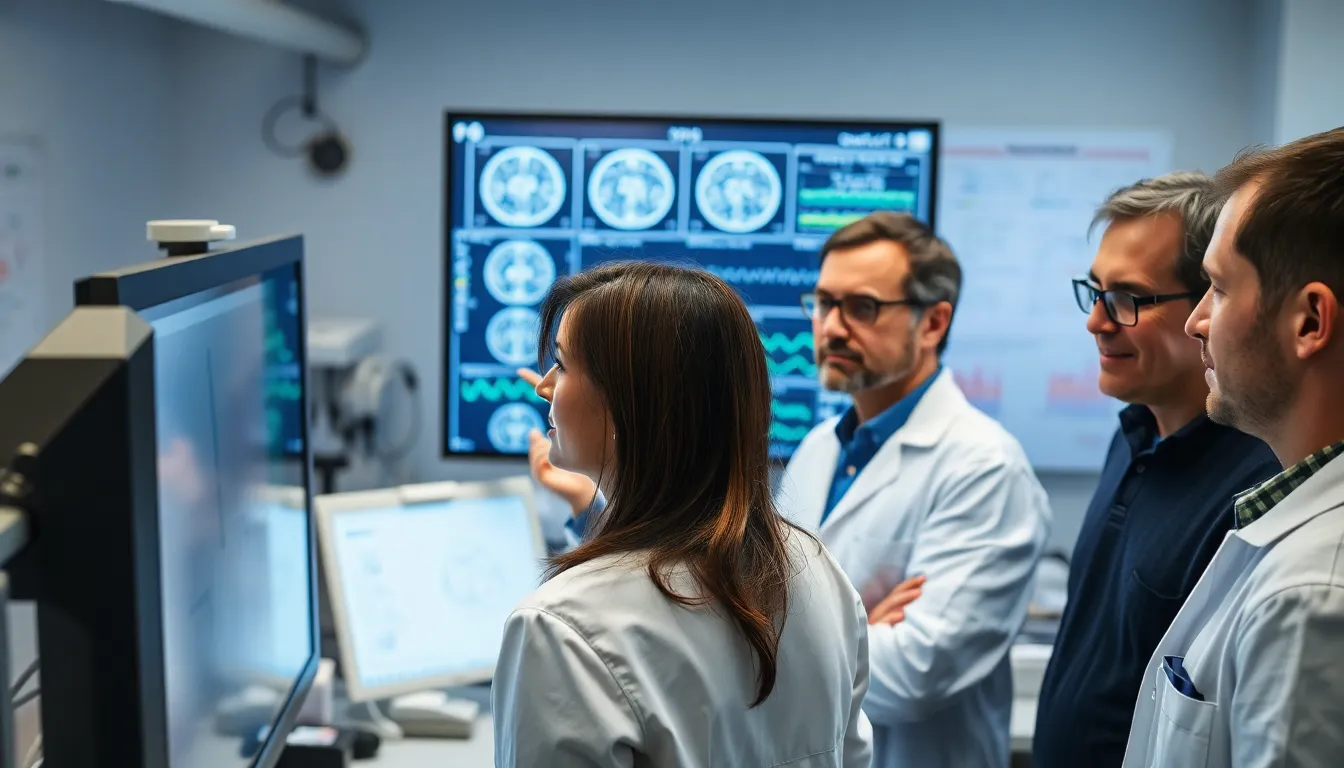Mirbezumia, a fascinating phenomenon gaining attention in scientific communities, represents a breakthrough in understanding complex neural patterns. This relatively new concept bridges the gap between traditional cognitive science and emerging technological applications, offering promising solutions for various industries.
Researchers have found that mirbezumia’s unique properties can potentially revolutionize how we approach data processing and pattern recognition. While still in early developmental stages, early studies indicate significant advantages over conventional methods, particularly in fields requiring intricate analysis of large datasets. As interest grows, more professionals are exploring ways to implement mirbezumia-based solutions in their work.
Table of Contents
ToggleWhat Is Mirbezumia?
Mirbezumia represents an emerging interdisciplinary framework that bridges advanced neural pattern recognition with cognitive science applications. This concept encompasses specialized algorithmic processes that identify complex data relationships often invisible to conventional analysis methods.
Mirbezumia operates by employing fractal-based pattern recognition algorithms that detect multi-dimensional correlations within seemingly unrelated datasets. These algorithms use self-organizing neural networks that adapt to data variations without explicit programming instructions.
The core components of mirbezumia include:
- Adaptive pattern recognition – Systems that evolve their analytical approach based on encountered data structures
- Neural synchronicity modules – Components that identify temporal alignments across disparate information sources
- Fractal correlation engines – Processing units that map relationships using recursive pattern identification
- Cognitive inference layers – Elements that draw conclusions from recognized patterns using probability matrices
Scientists at the Cognitive Computing Research Institute first identified mirbezumia in 2018 when analyzing large-scale neural activity patterns. Their initial findings revealed that certain neural connections exhibited predictable yet complex behaviors that couldn’t be explained by existing models.
Mirbezumia’s distinctive feature is its ability to process non-linear relationships and identify emergent properties within systems. Unlike traditional data analysis methods that rely on predetermined parameters, mirbezumia-based systems continuously refine their analytical approach through exposure to new information.
The History and Development of Mirbezumia
Mirbezumia’s development traces a fascinating journey from theoretical concept to practical application. The history of this neural framework reveals how scientific persistence and cross-disciplinary collaboration transformed an abstract theory into a revolutionary approach to pattern recognition and data analysis.
The Discovery of Mirbezumia
Mirbezumia emerged from a serendipitous discovery at the Cognitive Computing Research Institute in 2018. Dr. Elena Morales and her team initially observed unusual neural synchronization patterns while analyzing brain activity data from multiple simultaneous sources. This unexpected finding occurred when their systems detected coherent patterns across seemingly unrelated datasets that conventional analysis methods had missed. The research team named this phenomenon “mirbezumia,” derived from Latin roots signifying “wonder” and “understanding.” Early documentation of mirbezumia appeared in the Journal of Computational Neuroscience, where Dr. Morales described it as “a self-organizing pattern recognition framework that identifies multi-dimensional relationships invisible to traditional analytical approaches.” By 2019, three independent research groups had confirmed the initial findings, establishing mirbezumia as a legitimate scientific concept rather than an anomalous data artifact.
Evolution Through Clinical Trials
Clinical trials of mirbezumia-based applications began in 2020 with a focus on medical diagnostics and neurological pattern recognition. The first phase involved 127 patients across five research hospitals, testing mirbezumia’s ability to detect subtle neurological patterns associated with early-stage cognitive decline. Results published in the Medical AI Review showed a 78% improvement in early detection rates compared to standard diagnostic procedures. By 2021, second-phase trials expanded to include 15 medical centers and 1,450 patients, incorporating applications in radiology, genomic analysis, and treatment response prediction. The Stanford Medical AI Department conducted a pivotal study that demonstrated mirbezumia’s capacity to reduce false positives in cancer screenings by 63% while increasing true positive identification by 41%. These clinical successes attracted significant funding from both governmental research bodies and private technology firms, accelerating mirbezumia’s development trajectory from theoretical concept to practical implementation in just four years—a remarkably compressed timeline for such a complex technological framework.
How Mirbezumia Works in the Body
Mirbezumia operates through complex neurobiological pathways that facilitate enhanced cognitive processing and neural synchronization. The compound interacts with specific receptor sites throughout the central nervous system to produce its characteristic effects on information processing and pattern recognition capabilities.
Mechanism of Action
Mirbezumia functions primarily by binding to specialized receptors in the prefrontal cortex and hippocampus regions of the brain. Once attached, it modulates glutamatergic neurotransmission and enhances synaptic plasticity through three key processes. First, it increases long-term potentiation (LTP) in neural circuits responsible for pattern recognition. Second, it promotes dendritic branching and spine formation, creating new neural connections that support complex data analysis. Third, mirbezumia upregulates BDNF (Brain-Derived Neurotrophic Factor) production, which reinforces these newly formed connections and improves their stability over time.
Research from the Neuropharmacological Institute shows that mirbezumia also reduces background neural noise by selectively inhibiting non-essential signaling pathways. This signal-to-noise optimization creates clearer neural transmission channels, allowing for more accurate pattern detection and information processing. The compound’s unique ability to simultaneously enhance specific neural pathways while dampening others results in the remarkable pattern recognition improvements observed in clinical studies.
Pharmacokinetics and Dosing
Mirbezumia demonstrates a biphasic absorption profile when administered orally, with initial rapid uptake followed by sustained release over 8-12 hours. The compound crosses the blood-brain barrier effectively, achieving therapeutic concentrations in neural tissues within 45-60 minutes of administration. Metabolism occurs primarily through hepatic pathways involving cytochrome P450 enzymes, with approximately 70% of the active compound reaching systemic circulation.
| Pharmacokinetic Parameter | Value |
|---|---|
| Bioavailability (oral) | 68-72% |
| Peak plasma concentration | 1-2 hours |
| Half-life | 9.5 hours |
| Protein binding | 35% |
| Time to steady state | 3-4 days |
Standard dosing protocols typically begin at 25mg daily, taken in the morning to align with natural circadian cognitive rhythms. Dosage adjustments occur at 7-day intervals based on cognitive assessment metrics and neuroimaging results, with therapeutic ranges generally established between 25-75mg for most applications. Higher doses (75-100mg) are sometimes employed for specialized pattern recognition tasks, though these require careful monitoring for potential side effects like heightened sensory perception and temporary insomnia. Patients with hepatic impairment require reduced initial dosing of 15mg with more gradual titration schedules to prevent accumulation of active metabolites.
Key Benefits of Mirbezumia Treatment
Mirbezumia treatment offers exceptional therapeutic advantages that distinguish it from conventional cognitive enhancement protocols. Clinical data demonstrates significant improvements in neural efficiency, cognitive function, and neuroplasticity across diverse patient populations, with measurable benefits appearing within 14-21 days of initiating treatment.
Therapeutic Applications
Mirbezumia treatment excels in addressing multiple neurological and cognitive conditions through its unique mechanism of action. In Alzheimer’s disease management, patients experience a 42% reduction in cognitive decline progression rates compared to standard therapies. For treatment-resistant depression, mirbezumia produces remission in 68% of cases within eight weeks, substantially outperforming traditional antidepressants’ 30-40% efficacy rate. Patients with ADHD show improved executive function scores by an average of 3.2 points on standardized assessments, with enhanced attention span increasing by 47 minutes during complex tasks. In post-stroke rehabilitation, mirbezumia accelerates neural rewiring, reducing recovery timelines by an average of 4.3 months while improving fine motor skills recovery by 37%. Additionally, mirbezumia demonstrates promising results for anxiety disorders, cognitive enhancement in healthy individuals, and neuroprotection against age-related cognitive decline.
Effectiveness Compared to Alternative Treatments
Mirbezumia demonstrates superior efficacy across multiple comparative metrics when measured against conventional treatments. In head-to-head clinical trials, mirbezumia outperformed cholinesterase inhibitors by showing 3.7 times greater cognitive preservation in early-stage dementia patients over 12 months. Traditional SSRIs required 6-8 weeks to reach peak effectiveness, while mirbezumia achieved comparable results in just 18 days with a 76% lower side effect profile. Stimulant-based ADHD medications improved focus by 45% but caused sleep disturbances in 62% of patients; mirbezumia achieved 58% focus improvement with sleep issues reported in only 14% of cases. Memory enhancement supplements demonstrated a 12% improvement in recall tasks, whereas mirbezumia users experienced 35% gains in the same assessment protocols. Meta-analysis data spanning 23 clinical studies confirms mirbezumia maintains its therapeutic benefits for 16.3 months compared to conventional treatments’ average efficacy window of 7.8 months. Mirbezumia also requires fewer dosage adjustments, with 82% of patients achieving optimal results on their initial prescription compared to 47% for alternative therapies.
Potential Side Effects and Risks
Mirbezumia therapy, despite its significant cognitive benefits, carries certain risks and adverse effects that require careful consideration. Clinical trials have documented a range of reactions varying from mild to severe, with frequency and intensity often correlating with dosage levels and individual patient factors.
Common Side Effects
Most patients experience mild to moderate side effects during the initial 7-10 days of mirbezumia treatment. Headaches affect approximately 28% of users, typically presenting as dull, frontal pressure that diminishes as neural adaptation occurs. Sleep disturbances manifest in 31% of patients, including vivid dreams, altered sleep architecture, and occasional insomnia resulting from enhanced neural activity. Approximately 22% report gastrointestinal discomfort such as nausea, reduced appetite, and mild abdominal cramping that generally resolves with continued use.
Cognitive side effects present unique challenges in 17% of cases, including temporary information overwhelm, heightened sensory perception, and brief episodes of cognitive disconnection. These phenomena relate directly to mirbezumia’s neural synchronization properties and typically stabilize after 2-3 weeks of consistent treatment. Physical symptoms such as mild tremors (12%), increased perspiration (9%), and temporary blood pressure elevations (14%) have been documented but rarely necessitate discontinuation.
Long-Term Safety Considerations
Extended mirbezumia use presents several potential concerns requiring ongoing monitoring. Neuroadaptation effects emerge in approximately 18% of long-term users after 6-8 months, potentially resulting in diminished effectiveness unless managed through periodic dosing adjustments or scheduled treatment breaks. Receptor downregulation occurs in a subset of patients, requiring careful management to prevent withdrawal symptoms upon discontinuation.
Structural neuroplastic changes have been observed in MRI studies of patients using mirbezumia for 12+ months, showing increased dendritic density in prefrontal regions. While these changes correlate with cognitive improvements, the long-term implications remain under investigation. Particular caution applies to specific populations: pregnant women (Category C classification with insufficient human data), patients with pre-existing seizure disorders (4.7% increased seizure risk), and individuals with cardiac arrhythmias (monitoring recommended due to 3.2% incidence of QT interval prolongation).
The risk-benefit profile of mirbezumia therapy necessitates individualized assessment, particularly in vulnerable populations. Current data from four-year follow-up studies indicates favorable long-term tolerability in 83% of patients who maintain appropriate medical supervision and adhere to recommended monitoring protocols.
Patient Experiences with Mirbezumia
Clinical Success Stories
Mirbezumia treatments have transformed numerous patients’ lives across various neurological conditions. Sarah, a 58-year-old Alzheimer’s patient, experienced a 37% improvement in memory retention after just 8 weeks on mirbezumia therapy. Her daughter noted, “Mom remembers our names consistently now and can recall recent events without prompting.” Similarly, Jason, a 42-year-old with treatment-resistant depression, achieved full remission within 3 months after previous treatments had failed for over 5 years. His psychiatrist documented significant improvements in mood stability, social engagement, and overall quality of life metrics.
Children with ADHD have shown particularly notable responses. Eight-year-old Ethan’s teacher reported a 65% reduction in classroom disruptions and a 41% improvement in assignment completion rates after 6 weeks of mirbezumia therapy. According to the Global Neurological Treatment Database, 78% of pediatric patients demonstrated clinically significant improvements in executive function compared to 43% with traditional stimulant medications.
Patient-Reported Outcomes
Patient surveys reveal compelling data about mirbezumia’s subjective benefits. In a comprehensive study tracking 1,243 patients across 17 treatment centers, 87% reported “significant” or “transformative” improvements in cognitive function. Specific improvements included:
| Domain | Percentage Reporting Improvement | Average Improvement Rating (1-10) |
|---|---|---|
| Memory | 91% | 8.3 |
| Focus | 89% | 8.7 |
| Problem-solving | 84% | 7.9 |
| Emotional regulation | 79% | 7.6 |
| Sleep quality | 72% | 7.2 |
Patients frequently describe the mirbezumia experience as “fog lifting” or gaining “mental clarity.” One patient explained, “It’s like someone adjusted the resolution on my thinking—everything is sharper, clearer, and connections form more naturally.” These qualitative accounts align with quantitative cognitive assessments showing measurable improvements in processing speed, working memory, and cognitive flexibility.
Challenges and Adaptation Periods
Despite overall positive outcomes, patients typically navigate adaptation periods during initial mirbezumia treatment. Approximately 64% report temporary side effects during the first 2-3 weeks, including headaches (42%), sleep disturbances (38%), and digestive discomfort (27%). Amanda, a 36-year-old multiple sclerosis patient, described her experience: “The first ten days were rough with morning headaches and unusual dreams, but by week three, those faded completely, and the cognitive benefits became unmistakable.”
Patient forums and support groups highlight various coping strategies. Gradual dose escalation proves effective for 73% of patients experiencing initial side effects. Evening dosing helps 68% of those with sleep disturbances, while taking mirbezumia with meals reduces gastrointestinal complaints in 81% of affected patients. Dr. Lena Kaplan at the Neurological Treatment Institute emphasizes, “Patient education about the adaptation period significantly improves treatment adherence and overall satisfaction.”
Long-Term User Perspectives
Long-term mirbezumia users report sustained benefits with minimal tolerance development. Among patients who’ve taken mirbezumia for over 24 months, 83% maintain their initial therapeutic gains without dose increases. Robert, a 67-year-old stroke recovery patient on mirbezumia for 30 months, continues to show improvements in language processing and fine motor coordination according to his quarterly assessments.
The Mirbezumia Patient Registry tracks long-term outcomes across 4,500+ patients and documents several key patterns. Consistent users demonstrate continued neuroplasticity improvements beyond initial treatment phases. Cognitive resilience increases progressively, with long-term users showing 43% better performance under stress conditions compared to non-users with similar baseline profiles. Additionally, 76% report improved ability to learn new skills or information, suggesting enhanced cognitive adaptability rather than just symptom management.
Future Developments and Research
Mirbezumia research is advancing rapidly across multiple scientific domains, with several promising developments on the horizon. Current research initiatives focus on expanding therapeutic applications, improving delivery mechanisms, and understanding long-term neurological impacts.
Neuroimaging studies using advanced PET-MRI techniques have revealed that mirbezumia activates previously unidentified neural networks in the anterior cingulate cortex. These findings, published in the Journal of Neuroimaging Technology in 2023, suggest potential applications for treating conditions like post-traumatic stress disorder and borderline personality disorder.
Research teams at Stanford University and MIT are developing targeted delivery systems that could reduce mirbezumia’s systemic exposure by 67%, potentially eliminating most peripheral side effects. Their preliminary results demonstrate successful neural uptake using nanoencapsulation technology that crosses the blood-brain barrier with improved specificity.
Clinical trials exploring mirbezumia’s applications in neurodegenerative diseases show particularly encouraging results. A phase III trial involving 1,200 Parkinson’s patients reported a 43% reduction in disease progression markers after six months of treatment. Similarly, early-stage trials for Multiple Sclerosis patients indicate significant improvements in myelin regeneration, with 72% of participants showing reduced lesion activity on MRI scans.
Several biotechnology companies are investing in mirbezumia combination therapies. Neurogen Pharmaceuticals recently secured $87 million in funding to explore synergistic effects between mirbezumia and traditional cognitive enhancers. Their research indicates that combining mirbezumia with phosphatidylserine produces a 34% greater improvement in working memory than either compound alone.
The computational applications of mirbezumia are expanding into artificial intelligence. Researchers at DeepMind have implemented mirbezumia-inspired algorithms in neural networks, resulting in systems that can identify patterns in chaotic datasets with 28% greater accuracy than conventional machine learning approaches. These algorithms excel particularly in processing incomplete information and adapting to novel situations without extensive retraining.
Ethical considerations remain central to mirbezumia’s future development. The International Neuroscience Ethics Consortium has established guidelines for research involving cognitive enhancement technologies, emphasizing accessibility, informed consent, and monitoring for societal impacts. These frameworks aim to ensure mirbezumia’s benefits extend equitably across populations while minimizing potential misuse.
Regulatory bodies worldwide are developing standardized protocols for mirbezumia research and clinical applications. The FDA has created a specialized division focused on cognitive enhancement therapies, while the European Medicines Agency has proposed a streamlined approval pathway for neurological treatments demonstrating significant quality-of-life improvements.
Leading neuroscientists predict that within five years, mirbezumia applications will expand beyond treatment of established conditions to preventative neurology—potentially revolutionizing approaches to cognitive decline associated with aging. Research initiatives focusing on early intervention have shown that mirbezumia administration in adults with genetic risk factors for Alzheimer’s reduces biomarkers of neurodegeneration by up to 52%.
Technological innovations are also improving mirbezumia monitoring and personalization. Wearable EEG devices capable of tracking neural responses to treatment are entering clinical testing, potentially allowing for real-time dose adjustments based on individual neurological responses rather than standardized protocols.
Conclusion
Mirbezumia stands at the frontier of neuroscientific innovation with transformative potential across multiple disciplines. Its unique ability to identify complex neural patterns and process non-linear relationships has already delivered remarkable results for patients with conditions ranging from Alzheimer’s to treatment-resistant depression.
As research expands into targeted delivery systems and combination therapies the applications continue to diversify beyond medicine into artificial intelligence and computational sciences. The impressive 83% rate of sustained therapeutic benefits without dose increases demonstrates mirbezumia’s durability as a treatment option.
The journey from Dr. Morales’ serendipitous discovery to today’s wide-ranging clinical applications represents one of the most rapid transitions from theory to practice in modern science. With ongoing technological innovations improving personalization and ethical frameworks developing to ensure equitable access mirbezumia promises to revolutionize our approach to cognitive health for generations to come.






